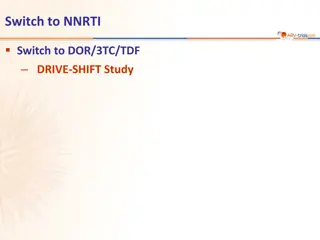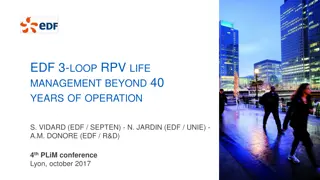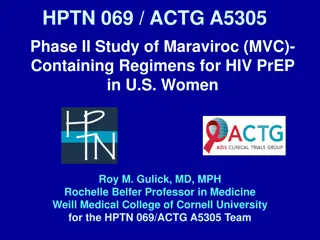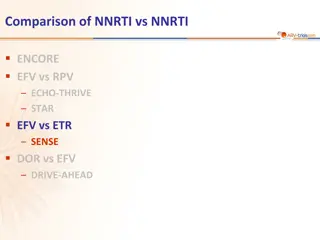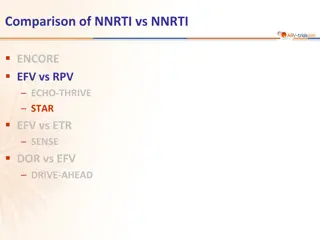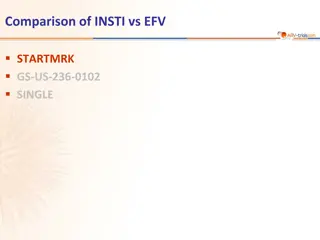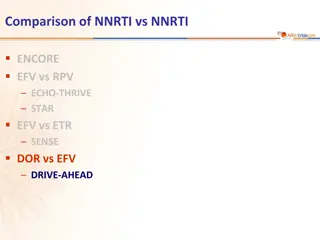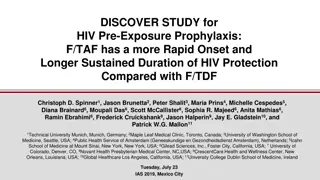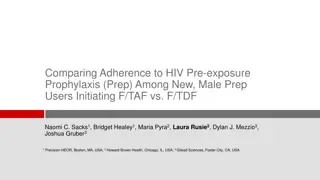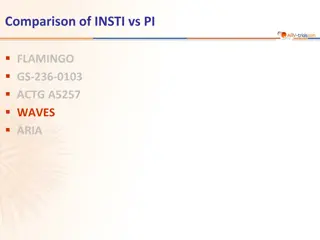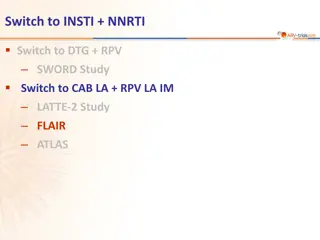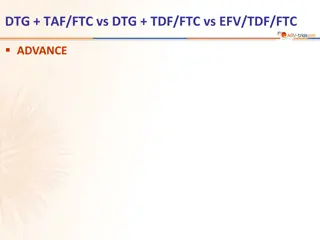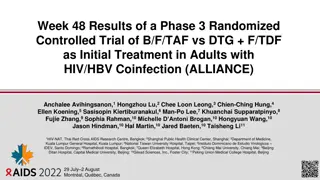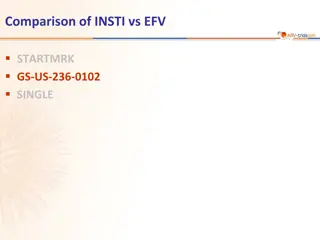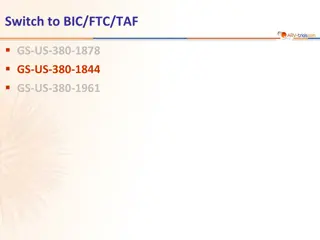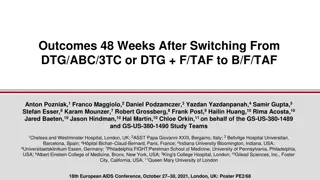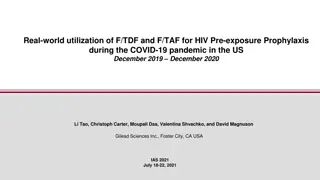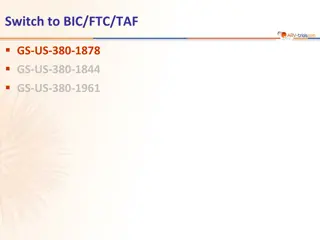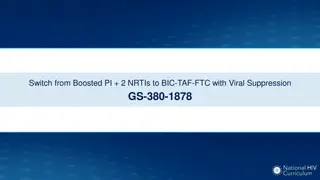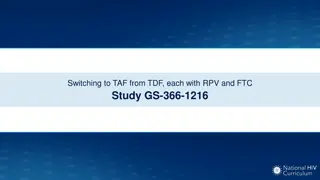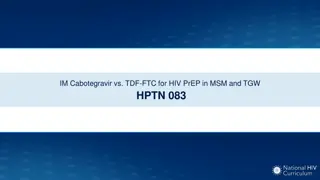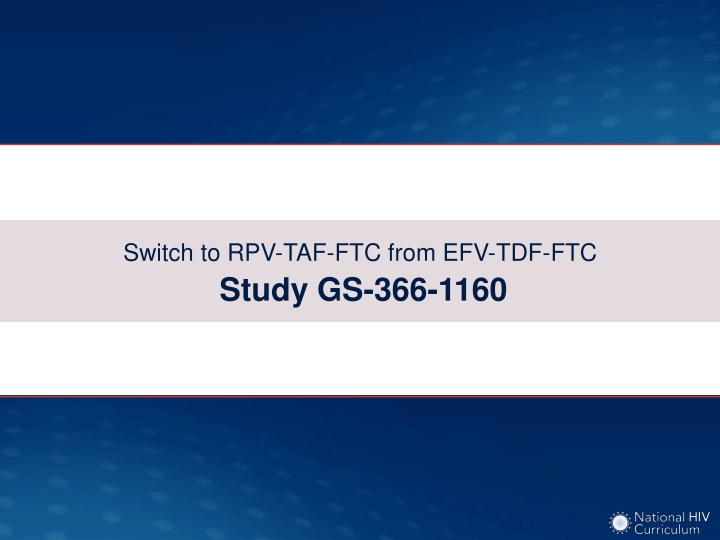
Switch to RPV-TAF-FTC from EFV-TDF-FTC Study GS-366-1160
Design Study GS-366-1160 Background Phase 3b, multinational, randomized, double-blind, placebo-controlled non-inferiority trial investigating the tolerability of switching to the single tablet regimen rilpivirine-tenofovir alafenamide-emtricitabine (RPV-TAF-FTC). Study results include virologic response, changes in bone mineral density, markers of proximal tubulopathy, and plasma lipid changes at Week 48.
Download Presentation

Please find below an Image/Link to download the presentation.
The content on the website is provided AS IS for your information and personal use only. It may not be sold, licensed, or shared on other websites without obtaining consent from the author. If you encounter any issues during the download, it is possible that the publisher has removed the file from their server.
You are allowed to download the files provided on this website for personal or commercial use, subject to the condition that they are used lawfully. All files are the property of their respective owners.
The content on the website is provided AS IS for your information and personal use only. It may not be sold, licensed, or shared on other websites without obtaining consent from the author.
E N D
Presentation Transcript
Switch to RPV-TAF-FTC from EFV-TDF-FTC Study GS-366-1160
Switch to RPV-TAF-FTC from EFV-TDF-FTC Study GS-366-1160: Design Study Design: Study GS-366-1160 Background: Phase 3b, multinational, randomized, double-blind, placebo controlled, non-inferiority trial investigating the tolerability of switching to the single tablet regimen rilpivirine-tenofovir alafenamide-emtricitabine (RPV-TAF-FTC) Switch Group RPV-TAF-FTC (n= 438) Inclusion Criteria (n = 881 randomized) - HIV-1-infected adults - HIV RNA <50 copies/mL for 6 months on EFV-TDF-FTC - Creatinine clearance at least 50 mL/min - No resistance to EFV, RPV, TDF, or FTC No Switch Group EFV-TDF-FTC (n = 437) Treatment Arms - Switch to RPV-TAF-FTC (Switch group) - Remain on EFV-TDF-FTC (No switch group) *NOTE: of 881 participants randomized, 6 were never treated (875 individuals treated) Source: DeJesus E, et al. Lancet HIV. 2017;4:e205-e213.
Switch to RPV-TAF-FTC from EFV-TDF-FTC Study GS-366-1160: Results Week 48 Virologic Response (FDA Snapshot Analysis) RPV-TAF-FTC (Switch) EFV-TDF-FTC (No Switch) 100 HIV RNA <50 copies/mL (%) 92 90 90 80 70 60 394/438 402/437 50 Source: DeJesus E, et al. Lancet HIV. 2017;4:e205-e213.
Switch to RPV-TAF-FTC from EFV-TDF-FTC Study GS-366-1160: Results Week 48: Changes in Bone Mineral Density (BMD) RPV-TAF-FTC (Switch) EFV-TDF-FTC (No Switch) 3 Mean Change in BMD (%) 2 1.65 1.28 1 0 -0.05 -0.13 -1 Hip Spine Source: DeJesus E, et al. Lancet HIV. 2017;4:e205-e213.
Switch to RPV-TAF-FTC from EFV-TDF-FTC Study GS-366-1160: Results Week 48: Changes in Markers of Proximal Tubulopathy RPV-TAF-FTC (Switch) EFV-TDF-FTC (No Switch) Median Change from Baseline (%) 50 29 25 17 12 0 -2 -14 -25 -28 -30 -41 -50 -75 Proteinuria (UPCR) Albuminuria (APCR) Retinol binding protein 2 microglobulin Source: DeJesus E, et al. Lancet HIV. 2017;4:e205-e213.
Switch to RPV-TAF-FTC from EFV-TDF-FTC Study GS-366-1160: Results Week 48: Change in Plasma Lipids from Baseline RPV-TAF-FTC (Switch) EFV-TDF-FTC (No Switch) 5 Change in Median Value (mg/dL) -1 -2 -2 -3 -3 -5 -4 -4 -9 -15 Total Cholesterol LDL HDL Triglycerides Source: DeJesus E, et al. Lancet HIV. 2017;4:e205-e213.
Switch to RPV-TAF-FTC from EFV-TDF-FTC Study GS-366-1160: Conclusion Interpretation: Switching to rilpivirine, emtricitabine, and tenofovir alafenamide from efavirenz, emtricitabine, and tenofovir disoproxil fumarate was non-inferior in maintaining viral suppression and was well tolerated at 48 weeks. These findings support guidelines recommending tenofovir alafenamide-based regimens, including coformulation with rilpivirine and emtricitabine, as initial and ongoing treatment for HIV-1 infection. Source: DeJesus E, et al. Lancet HIV. 2017;4:e205-e213.
Acknowledgment The National HIV Curriculum is an AIDS Education and Training Center (AETC) Program supported by the Health Resources and Services Administration (HRSA) of the U.S. Department of Health and Human Services (HHS) as part of an award totaling $800,000 with 0% financed with non-governmental sources. This project is led by the University of Washington s Infectious Diseases Education and Assessment (IDEA) Program. The content in this presentation are those of the author(s) and do not necessarily represent the official views of, nor an endorsement, by HRSA, HHS, or the U.S. Government.

